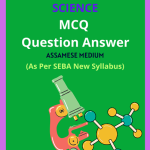Class 8 Science MCQ Chapter 4 Materials: Metals and Non-Metals Solutions in English Medium, Class 8 Science Multiple Choice Question Answer in English to each chapter is provided in the list so that you can easily browse throughout different chapters Class 8 Science MCQ Chapter 4 Materials: Metals and Non-Metals Notes and select need one.
Class 8 Science MCQ Chapter 4 Materials: Metals and Non-Metals
Also, you can read the SCERT book online in these sections Class 8 Science Objective Type Solutions by Expert Teachers as per SCERT (CBSE) Book guidelines. These solutions are part of SCERT All Subject Solutions. Here we have given Assam Class 8 Science MCQs Solutions in English for All Subject, You can practice these here.
Materials: Metals and Non-Metals
Chapter – 4
| MCQ |
1. In the following list, choose the one that is an acidic oxide.
(a) Na2O.
(b) carbon dioxide.
(c) carbon monoxide.
(d) aluminium oxide.
Ans: (c) carbon monoxide.
2. ‘X’ has the atomic number 12 and is found in the periodic table. Which inert gas is the most similar to X?
(a) He.
(b) Ar.
(c) Ne.
(d) Kr.
Ans: (c) Ne.
3. The process by which a carbonate ore is heated to high temperatures in the absence of oxygen in order to convert it to metal oxide is referred to as:
(a) roasting.
(b) reduction.
(c) calcination.
(d) smelting.
Ans: (c) calcination.
4. The oxidation of moderately reactive metals such as zinc, iron, nickel, tin, copper, and so on is reduced by using.
(a) Aluminium as reducing agent.
(b) Sodium as reducing agent.
(c) Carbon as reducing agent.
(d) Calcium as reducing agent.
Ans: (c) Carbon as reducing agent.
5. _____________ and ______________ are ignited with a burning magnesium ribbon in thermite welding, which results in the production of molten iron metal as well as a significant amount of heat being released.
(a) Iron (III) oxide and aluminium powder are used in this process.
(b) iron (II) oxide and aluminium powder.
(c) Iron (III) chloride and aluminium powder.
(d) Iron (III) sulphate and aluminium powder.
Ans: (a) Iron (III) oxide and aluminium powder are used in this process.
6. Galvanisation is a technique for protecting iron from corrosion by coating it with a thin layer of:
(a) Gallium.
(b) Aluminium.
(c) Zinc.
(d) Silver.
Ans: (c) Zinc.
7. An element X is soft and can be cut with a knife, according to the definition. This is extremely reactive to air and cannot be kept open in the presence of air for long periods of time. When it comes into contact with water, it reacts violently. Choose one of the elements from the list below.
(a) Mg.
(b) Na.
(c) P.
(d) Ca.
Ans: (b) Na.
8. The reaction between X and Y results in the formation of compound Z. X loses an electron, and Y gains an electron as a result of this. Which of the following characteristics is not demonstrated by Z?
(a) The melting point is high.
(b) The melting point is low.
(c) When in a molten state, it conducts electricity.
(d) It manifests itself as a solid.
Ans: (c) When in a molten state, it conducts electricity.
9. Which of the following is a non-metal?
(a) Aluminium.
(b) Oxygen.
(c) Iron.
(d) Silver.
Ans: (b) Oxygen.
10. Metalloids possess the properties of.
(a) metals.
(b) non-metals.
(c) both metals and nonmetals.
(d) none of these.
Ans: (c) both metals and nonmetals.
11. Which of the following is a characteristic property of metals?
(a) Poor conductors of electricity.
(b) Malleability.
(c) Brittle nature.
(d) Dull appearance.
Ans: (b) Malleability.
12. The most reactive metal is:
(a) copper.
(b) zinc.
(c) potassium.
(d) gold.
Ans: (c) potassium.
13. Which of the following is a characteristic property of metals?
(a) Poor conductors of heat.
(b) Dull appearance.
(c) Malleability.
(d) Brittle nature.
Ans: (c) Malleability.
14. Which of the following is an example of a non-metal?
(a) Copper.
(b) Iron.
(c) Sulphur.
(d) Silver.
Ans: (c) Sulphur.
15. Which property is commonly associated with non-metals?
(a) High melting points.
(b) High density.
(C) Good conductors of electricity.
(d) Brittle nature when in solid form.
Ans: (d) Brittle nature when in solid form.

Hi! my Name is Parimal Roy. I have completed my Bachelor’s degree in Philosophy (B.A.) from Silapathar General College. Currently, I am working as an HR Manager at Dev Library. It is a website that provides study materials for students from Class 3 to 12, including SCERT and NCERT notes. It also offers resources for BA, B.Com, B.Sc, and Computer Science, along with postgraduate notes. Besides study materials, the website has novels, eBooks, health and finance articles, biographies, quotes, and more.




